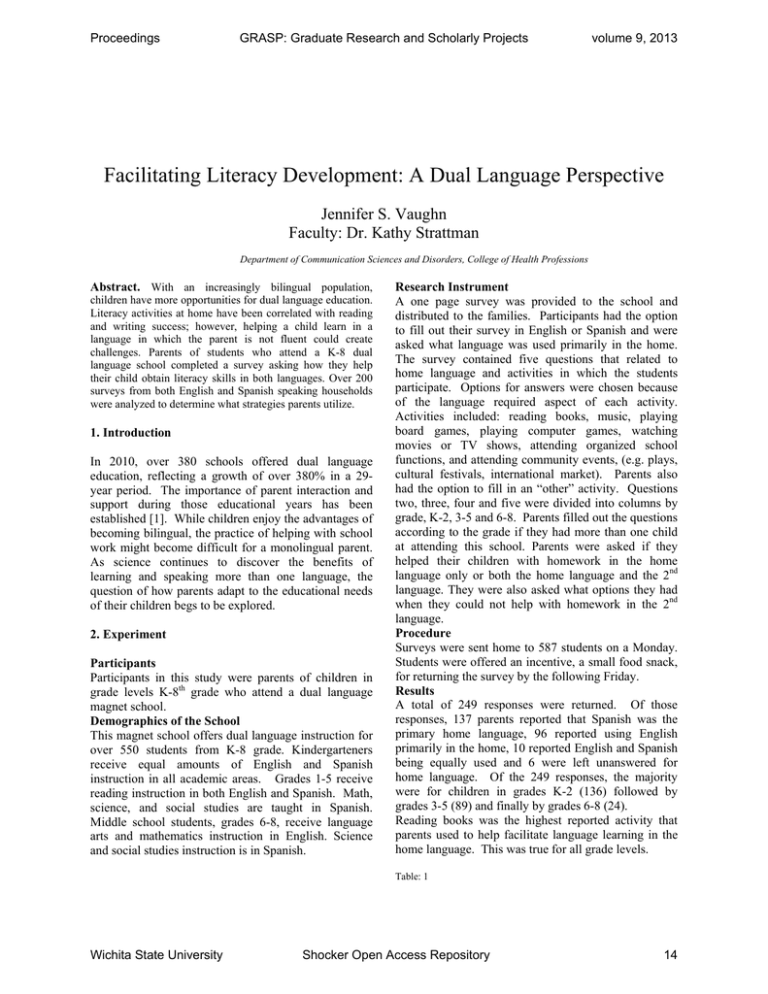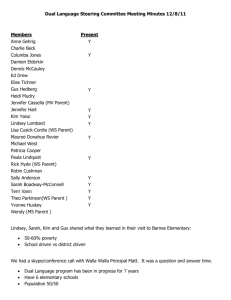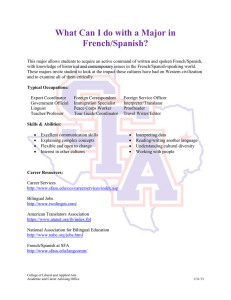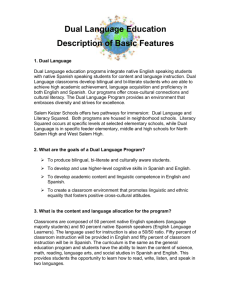Facilitating Literacy Development: A Dual Language Perspective Jennifer S. Vaughn
advertisement

Proceedings GRASP: Graduate Research and Scholarly Projects volume 9, 2013 Facilitating Literacy Development: A Dual Language Perspective Jennifer S. Vaughn Faculty: Dr. Kathy Strattman Department of Communication Sciences and Disorders, College of Health Professions Abstract. With an increasingly bilingual population, children have more opportunities for dual language education. Literacy activities at home have been correlated with reading and writing success; however, helping a child learn in a language in which the parent is not fluent could create challenges. Parents of students who attend a K-8 dual language school completed a survey asking how they help their child obtain literacy skills in both languages. Over 200 surveys from both English and Spanish speaking households were analyzed to determine what strategies parents utilize. 1. Introduction In 2010, over 380 schools offered dual language education, reflecting a growth of over 380% in a 29year period. The importance of parent interaction and support during those educational years has been established [1]. While children enjoy the advantages of becoming bilingual, the practice of helping with school work might become difficult for a monolingual parent. As science continues to discover the benefits of learning and speaking more than one language, the question of how parents adapt to the educational needs of their children begs to be explored. 2. Experiment Participants Participants in this study were parents of children in grade levels K-8th grade who attend a dual language magnet school. Demographics of the School This magnet school offers dual language instruction for over 550 students from K-8 grade. Kindergarteners receive equal amounts of English and Spanish instruction in all academic areas. Grades 1-5 receive reading instruction in both English and Spanish. Math, science, and social studies are taught in Spanish. Middle school students, grades 6-8, receive language arts and mathematics instruction in English. Science and social studies instruction is in Spanish. Research Instrument A one page survey was provided to the school and distributed to the families. Participants had the option to fill out their survey in English or Spanish and were asked what language was used primarily in the home. The survey contained five questions that related to home language and activities in which the students participate. Options for answers were chosen because of the language required aspect of each activity. Activities included: reading books, music, playing board games, playing computer games, watching movies or TV shows, attending organized school functions, and attending community events, (e.g. plays, cultural festivals, international market). Parents also had the option to fill in an “other” activity. Questions two, three, four and five were divided into columns by grade, K-2, 3-5 and 6-8. Parents filled out the questions according to the grade if they had more than one child at attending this school. Parents were asked if they helped their children with homework in the home language only or both the home language and the 2nd language. They were also asked what options they had when they could not help with homework in the 2nd language. Procedure Surveys were sent home to 587 students on a Monday. Students were offered an incentive, a small food snack, for returning the survey by the following Friday. Results A total of 249 responses were returned. Of those responses, 137 parents reported that Spanish was the primary home language, 96 reported using English primarily in the home, 10 reported English and Spanish being equally used and 6 were left unanswered for home language. Of the 249 responses, the majority were for children in grades K-2 (136) followed by grades 3-5 (89) and finally by grades 6-8 (24). Reading books was the highest reported activity that parents used to help facilitate language learning in the home language. This was true for all grade levels. Table: 1 Wichita State University Shocker Open Access Repository 14 Proceedings GRASP: Graduate Research and Scholarly Projects Activities used to facilitate language learning in home language (by grade level) K-2 3-5 6-8 Read books 95% 94% 83% Music 57% 66% 63% Play board games 47% 45% 21% Play computer games 50% 54% 46% Watch movies or TV shows 65% 73% 71% Attend school functions 44% 51% 29% Attend community events 31% 38% 42% Other 15% 10% 29% This remained true for the non-home language development for grades K-5 but the percent of book use declined for the 6-8 grades and was on even par with watching movies or TV shows to facilitate the nonhome language. Watching movies or TV shows was more prevalent for developing the English language, regardless of home language. Playing computer games ranked higher for home language development when the home language was English, but little difference was observed using computer games to develop the 2nd language, regardless of home language. Other activities to develop home language were: using the library, going on outings (e.g. Zoo), and talking/having conversations. Answers were similar for developing 2nd language and also included finding others who spoke the language and reviewing previous schoolwork. Regardless of home language, when parents were not able to help their students with homework, most found assistance from teachers or other family members or siblings. For grades K-5, the majority of English- and Spanish-speaking parents felt they were able to help their students with their homework in both languages. Discussion As expected, the study shows that books remain a highly utilized tool to facilitate language learning in the home language. Unexpectedly, media (e.g. movies, TV shows, computer games) was a very close second. Further investigation into types of media could be done. In both English-speaking and Spanish-speaking homes, outside sources and family connections were frequently used in facilitating the learning of the non-home language. Many families relied on older siblings already in the dual language program to assist younger siblings with homework. Followed by the use of books, English-speaking households tended to look for outside sources to help facilitate the 2nd language with school functions or community events while Spanish-speaking households relied more on media. Differences could be due to the greater amounts of English language media available and relatively minimal options for hearing Spanish in mainstream media. Wichita State University volume 9, 2013 Interestingly, when parents couldn’t help with homework or a school project in the non-home language, they reported “finding another student to help them” (other than a family member) was rarely an option. While many parents see that attending a dual language school is a way for their child to have a positive cultural experience [2], these findings may reveal this cultural experience is not happening, at least outside of the school setting. Many parents did reference the fact that they “talk” with their children to facilitate home and non-home language, pointing out an obvious pathway to improving language development, conversation! Significance Parents participate in their children’s education in a variety of ways. While a monolingual education setting calls for parental involvement, dual language learning uses many of the same tools to facilitate learning in both the home and non-home language. Ease of access to all forms of language and language-based activities may contribute. For instance, media in the English language is more readily available and utilized for language learning. 3. Conclusions Studies in early literacy learning [3] revealed that expressive language is enhanced by shared reading experiences. The importance of books and parental involvement are mirrored in the parent’s responses in the survey for this study. Additionally, in the dual language learning environment, home-language did not play a role in the preference of books as a tool used for language development for the primary or 2nd language. The high return rate of surveys exhibits how motivated these parents are to be active participants in their children’s dual language educational experience. 4. References [1] Van Kleeck, A., & Schuele, C.M. (2010). Historical perspectives on literacy in early childhood.American Journal of Speech-Language Pathology. 19. 341-355. [2] Craig, B. (1996). Parental attitudes towards bilingualism in a local two-way immersion program. The Bilingual Research Journal, 20(34), 383-410. [3] Trivette, C.M., Dunst, C.J. & Gorman, E. (2010). Effects of parent-mediated joint book reading on the early language development of toddlers and preschoolers. CELL Reviews. 3(2). Shocker Open Access Repository 15


